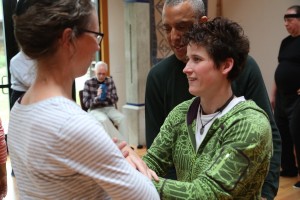(This article was originally published in the T’ai Chi Foundation’s Teaching Forum)
Tai Chi is great practical knowledge of human mind-body balance needed in the current day. When studying taijiquan one moves through many stages, all of them engrossingly fun and challenging. There are many takeaways from this study, each of great value. One of the most important is that we learn that we can relax. Life gets better with relaxation. Our health improves, our balance, both physical and emotional improves and our spirit is nourished.
Teaching methods for this practice vary. Too much thought fools us into trying to think our way through it. What we actually need is to feel it in our bodies. Nonetheless, having a comprehensive understanding or roadmap is also truly valuable. It allows one to avoid the pitfalls of imaginative wishful thinking that can delay our actual embodiment of the basically simple (and tremendously challenging) principles involved. Taijiquan is a martial art, but the true value of the study goes far beyond any aspect of fighting. The principles that make it successful are the same that can help us move through life with harmony.
The basics are simple. We learn to find our footing on the earth and develop actual awareness of our feet on the ground. As we do, while relaxing the legs and the entire body, we then learn how to move without disturbing our ground. Gradually we develop a new awareness of our true strength. This is not the strength of muscle resistance, but one that comes from the ground. A simple analogy is that of the tenuous balance of a christmas tree, even one with a wide and stable base, compared to the stability of a live tree rooted in the earth. Our phases of learning can almost follow this analogy in that when we start we might have a small base. This increases. Then we start to develop root. Gradually it deepens the more we relax. Ultimately it brings nourishment up from the ground while the tree attracts the energy of the heavens. This leads to a fullness of emptiness, light and energy that only appears when we let go of tension and external strength of muscle resistance. We experience the alive energy of Qi in our body.
To take the internal strength-without-resistance (strength through softness) into the world, in movement, we must open the full functionality of our hip joints (referred to as the kua). We learn to turn and step utilizing the potentially free movement in these joints. This allows the alignment of the body to maintain the openness of a channel between the heavens and the earth. Alignment here, is another key principle often initially misunderstood as forceful straightening of the body, or holding a ‘correct’ position. Over time we learn that as we relax with the intention of hanging loose from the top, as if from a string from above, we open the channel to filling from below. This gives us a quality and presence that becomes a force for peace and harmonious interaction.
Now, there is another key piece that brings us back to the all important hip joints. In our form practice we develop our knowledge of the available territory under our feet. How to move smoothly from one foot to the other, when and how we can turn without compromising our balance or being stuck, all with the aware emptiness to interpret the needs of the moment.
The goal is to relax and observe these principles within ourselves – within our bodies. We become clear that this is not a thought process, but an awareness available to us via the dantian. Our root deepens, our energy increases and “the tree” becomes more bushy and full of life. Now there are lessons that we learn in interaction with others. In the challenge of working with a pushing partner, we discover that to maintain relaxed contact we must move the whole “tree” (from the center – the dantian) even while we avail ourselves of the subtlety of our articulated limbs. Quite often we can confuse softness, a concept which can seem foreign and elusive, with collapse and limpness. This is only natural, since our main paradigm for relaxation is collapsing on a couch. Practice of taijiquan leads us to a much more dynamic form of relaxation, one that we can take with us as we move through the world.
The martial teaching of taijiquan is one of non-opposition often described as getting out of the way of force. But truly it is more subtle than simple dodging. Instead, with relaxation we develop the ability to make and maintain contact with our partner with an open-hearted touch that neither offers resistant pressure, nor shrinks away in fear. The key factor involved in this (physical) contact is that we modulate it not so much with the articulation (and activity) of the arms, but with shifts in the center mass of the body and articulation in the legs. Just enough movement to still maintain contact without resistance. This happens in the context of a full awareness (dantian rather than thinking mind) of the terrain in which we can move. We must know where we are, where our feet are and maintain the sensation of rootedness with awareness of the space we inhabit physically.
To do this, we must establish a clear separation between our thinking mind and our physical kinesthetic awareness. Although the thinking mind is capable of understanding this process, its desire to analyze is far too slow to provide the appropriate answer in a moment of need for clear physical response. The emotions too play a part here. For if we react emotionally without the clarity of a relaxed response, we will always over-react. So, the emotions must be calmed as we relax and breathe. We utilize the mind to remember and direct our attention to the dantian awareness. The dantian awareness provides us a harmonious response as we maintain contact and preserve our own balance.
Six steps involved in successful sensing hands:
- Mastery of the terrain (dantian awareness)
- Development of root (sung)
- Opening alignment – life all the way to the fingertips (peng)
- Articulation of the key joints to allow continued relaxation (open responsive kua)
- Calm, open-hearted connection and adherence (Love)
- Harmonious softness of centered movement, response and following (empathy and compassion)
The psychological challenge of pushing hands is an opportunity to move towards transcendence of the existential angst of sadness, anger & fear. These manifest in our practice as judgement (freezing), fight and flight, the three ‘Fs’. The ground within which we practice is dantian awareness, the intention of promoting balance and pacification of conflict in service of the ultimate goal of a unified humanity. Our school, The School of T’ai Chi Chuan & T’ai Chi Foundation grows from and is dedicated to these principles. Each aspect of our practice reflects this and supports our core mission to provide a toolset for promoting health, harmony and peace in the world.
Our core activity has been and will continue to be working towards and bringing those interested into the full embodiment of Tai Chi, the supreme principle, as manifested across an embodiment of the practice of taijiquan. I dream also of the day when TCF’s major activity will be the outreach to a much larger segment of humanity (beyond taiji enthusiasts) to give access to the practical knowledge contained in this pursuit to all people in need.
Greg Woodson

